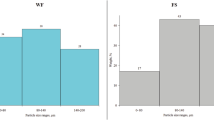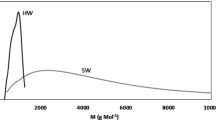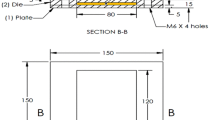Abstract
The aim of this work was preparation and initial investigation of biodegradable polymer composites from renewable recourses filled with industrial waste materials for potential application as mulching coatings. Crosslinked polymer of epoxidized linseed oil and 1-hydroxyethane-1,1-diphosphonic acid was used as polymeric binder in the prepared composites. The following industrial waste materials of natural origin were used as fillers: horn meal, phosphogypsum, rapeseed cake, pine needles, pine bark, grain mill waste, and mix of grain waste and weeds. The composite films can be formed in one day at (20–25) °C. The curing time was increased with an increase of dilution and amount of filler, as well as with reduction of temperature. Mechanical and thermal properties, moisture permeability, surface wetting, swelling in water, combustibility, and biodegradability of the formed polymer composite films were evaluated. It was found that mechanical characteristics of the prepared polymer composites deteriorated with increase of amount of filler. Tensile strength, Young modulus, and elongation at break of composite films were in the range of (0.3–1.8) MPa, (0.8–6.8) MPa, and (17–51) %, respectively. The values of wetting angle varied from 71° to 90° and were lower than that of commercial agrofoil. Swelling values were in the range of (2–22) % and depended on type and amount of filler, particle size, and hydrophobicity. The samples with lower amounts and less hydrophobic fillers having the higher particle size exhibited higher swelling values. Prepared composite films were found to be able to retain moisture in soil in 2–2.5 times more than soil without coating after 1 month, they were by ca. (4–20) % less flammable than conventional synthetic polymer films, biodegradable (their mass loss was (36–60) % during 6 months exposition in soil), and therefore could be applied as sprayable or pre-cured mulching films in agriculture and forestry.









Similar content being viewed by others
References
Hayes DG, Dharmalingam S, Wadsworth LC, Leonas KK, Miles C, Inglis DA (2012) Biodegradable agricultural mulches derived from biopolymers. In: Khemani K, Scholz C (eds) Degradable polymers and materials: principles and practice, 2nd edn. American Chemical Society, Washington, DC
Gurunathan T, Mohanty S, Nayak SK (2015) A review of the recent developments in biocomposites based on natural fibres and their application perspectives. Compos Part A 77:1–25
Brodhagen M, Peyron M, Miles C, Inglis DA (2015) Biodegradable plastic agricultural mulches and key features of microbial degradation. Appl Microbiol Biotechnol 99:1039–1056
Kasirajan S, Ngouajio M (2012) Polyethylene and biodegradable mulches for agricultural applications: a review. Agron Sustain Dev 32:501–529
Yang N, Sun ZX, Feng LS, Zheng MZ, Chi DC, Meng WZ, Hou ZY, Bai W, Li KY (2015) Plastic film mulching for water-efficient agricultural applications and degradable films materials development research. Mater Manuf Process 30:143–154
Steinmetz Z, Wollmann C, Schaefer M, Buchmann C, David J, Troeger J, Munoz K, Froer O, Schaumann GE (2016) Plastic mulching in agriculture. Trading short-term agronomic benefits for long-term soil degradation? Sci Total Environ 550:690–705
Sartore L, Vox G, Schettini E (2013) Preparation and performance of novel biodegradable polymeric materials based on hydrolyzed proteins for agricultural application. J Polym Environ 21:718–725
Vox G, Santagata G, Malinconico M, Immirzi B, Mugnozza GS, Schettini E (2013) Biodegradable films and spray coatings as eco-friendly alternative to petro-chemical derived mulching films. J Agr Eng 2013:e44
Immirzia B, Santagataa G, Vox G, Schettini E (2009) Preparation, characterisation and field-testing of a biodegradable sodium alginate-based spray mulch. Biosyst Eng 102:461–472
Väisänen T, Haapala A, Lappalainen R, Tomppo L (2016) Utilization of agricultural and forest industry waste and residues in natural fiber-polymer composites: a review. Waste Manag 54:62–73
Virtanen S, Chowreddy RR, Irmak S, Honkapaa K, Isom L (2016) Food industry co-streams: potential raw materials for biodegradable mulch film applications. J Polym Environ 25:1110–1130
Bashir ASM, Manusamy Y (2015) Recent developments in biocomposites reinforced with natural biofillers from food waste. Polym-Plast Technol 54:87–99
Saba N, Jawaid M, Alothman OY, Paridah MT, Hassan A (2016) Recent advances in epoxy resin, natural fiber-reinforced epoxy composites and their application. J Reinf Plast Compos 35(6):447–470
Zhang CH, Garrison TF, Madbouly SA, Kessler MR (2017) Recent advances in vegetable oil-based polymers and their composites. Prog Polym Sci 71:91–143
Saba N, Tahir PM, jawaid M (2014) A review on potentiality of nano filler/natural fiber filled polymer hybrid composites. Polymers 6:2247–2273
Samper MD, Petrucci R, Sanchez-Nacher L, Balart R, Kenny JM (2015) New environmentally friendly composite laminates with epoxidized linseed oil (ELO) and slate fiber fabrics. Compos B 71:203–209
Ngo TT, Lambert CA, Kohl JG (2014) Characterization of compostability and mechanical properties for linseed oil resin composites reinforced with natural fibers. Polym Plast Technol Eng 53:1215–1222
Pfister DP, Larock RC (2012) Cationically cured natural oil-based green composites: effect of the natural oil and the agricultural fiber. J Appl Polym Sci 123:1392–1400
Rueda MM, Auscher MC, Fulchiron R, Perie T, Martin G, Sonntag P, Cassagnau P (2017) Rheology and applications of highly filled polymers: a review of current understanding. Prog Polym Sci 66:22–53
Sobczak L, Bruggemann O, Putz RF (2013) Polyolefin composites with natural fibers and wood-modification of the fiber-filler-matrix interaction. J Appl Polym Sci 127:1–17
Sartore L, Bignotti F, Pandini S, D’Amore A, Di Landro L (2016) Green composites and blends from leather industry waste. Polym Compos 37(12):3416–3422
Adhikari R, Bristow KL, Casey PS, Freischmidt G, Hornbuckle JW, Adhikari B (2016) Preformed and sprayable polymeric mulch film to improve agricultural water use efficiency. Agr Water Manag 169:1–13
Santagata G, Malinconico M, Immirzi B, Schettini E, Scarascia Mugnozza G, Vox G (2014) An overview of biodegradable films and spray coatings as sustainable alternative to oil-based mulching films. Acta Hortic 1037:921–928
Johnston P, Freischmidt G, Easton CD, Greaves M, Casey PS, Bristow KL, Gunatillake PA, Adhikari R (2016) Hydrophobic-hydrophilic surface switching properties of nonchain extended poly(urethane)s for use in agriculture to minimize soil water evaporation and permit water infiltration. J Appl Polym Sci. https://doi.org/10.1002/APP.44756
Adhikari R, Bristow KL, Casey PS, Freischmidt G, Hornbuckle JW (2015) Novel sprayable biodegradable polymer membrane to minimise soil evaporation. In: International Conference on Technologies for Sustainable Development (ICTSD 2015). Don Bosco Inst Technol DBIT, Mumbai
Malinconico M, Immirzi B, Santagata G, Schettini E, Vox G, Scarascia Mugnozza G (2008) An overview on innovative biodegradable materials for agricultural applications. In: Moeller HW (ed) Progress in polymer degradation and stability research. Nova Science, New York
Mosiewicki MA, Aranguren MI (2013) A short review on novel biocomposites based on plant oil precursors. Eur Polym J 49:1243–1256
Biermann U, Bornscheuer U, Meier MAR, Metzger JO, Schafer HJ (2011) Oils and fats as renewable raw materials in chemistry. Angew Chem Int Ed 50:3854–3871
Montero de Espinosa L, Meier MAR (2011) Plant oils: the perfect renewable resource for polymer science ? Eur Polym J 47:837–852
Huang SW, Zhuo RX (2008) Recent advances in polyphosphoester and polyphosphoramidate-based biomaterials. Phosphorus Sulfur 183:340–348
Wang YC, Yuan YY, Du JZ, Yang XZ, Wang J (2009) Recent progress in polyphosphoesters: from controlled synthesis to biomedical applications. Macromol Biosci 9:1154–1164
Kasetaite S, Ostrauskaite J, Grazuleviciene V, Svediene J, Bridziuviene D (2014) Camelina oil- and linseed oil-based polymers with bisphosphonate crosslinks. J Appl Polym Sci. https://doi.org/10.1002/APP.40683
ISO 846 (1997) Plastics—evaluation of the action of microorganisms
Chandra R, Rustgi R (1998) Biodegradable polymers. Prog Polym Sci 23:1273–1335
Llevot A, Meier MAR (2016) Renewability—a principle of utmost importance! Green Chem 18:4800–4803
Brown JE, Channell-Butcher C (2001) Black plastic mulch and drip irrigation affect growth and performance of bell pepper. J Veg Crop Prod 7:109–112
Chalker-Scott L (2007) Impact of mulches on landscape plants and the environment—a review. J Environ Hortic 25:239–249
Mahmoudpour MA, Stapleton JJ (1997) Influence of sprayable mulch color on yield of eggplant (Solanum melongena L. cv. Millionaire). Sci Hortic 70:331–338
Vox G, Scarascia Mugnozza G, Schettini E, de Palma L, Tarricone L, Gentilesco G, Vitali M (2012) Radiometric properties of plastic films for vineyard covering and their influence on vine physiology and production. Acta Hortic 956:465–472
Schettini E, De Salvador FR, Scarascia-Mugnozza G, Vox G (2011) Radiometric properties of photoselective and photoluminescent greenhouse plastic films and their effects on peach and cherry tree growth. J Hortic Sci Biotechnol 86(1):79–83
Schettini E, Vox G, De Lucia B (2007) Effects of the radiometric properties of innovative biodegradable mulching materials on snapdragon cultivation. Sci Hortic 112:456–461
Tarara JM (2000) Microclimate modification with plastic mulch. Hortscience 35:169–180
Mngomezulu ME, John MJ, Jacobs V, Luyt AS (2014) Review on flammability of biofibres and biocomposites. Carbohydr Polym 111:149–182
Idumah CI, Hassan A (2016) Emerging trends in flame retardancy of biofibers, biopolymers, biocomposites, and bionanocomposites. Rev Chem Eng 32(1):115–148
Younis AA (2017) Flammability properties of polypropylene containing montmorillonite and some of silicon compounds. Egypt J Petrol 26:1–7
Merlini C, Soldi V, Barra GMO (2011) Influence of fiber surface treatment and length on physico-chemical properties of short random banana fiber-reinforced castor oil polyurethane composites. Polym Test 30:833–840
Khot SN, Lascala JJ, Can E, Morye SS, Williams GI, Palmese GR, Kusefoglu SH, Wool RP (2001) Development and application of triglyceride-based polymers and composites. J Appl Polym Sci 82:703–723
Casado U, Marcovich NE, Aranguren MI, Mosiewicki MA (2009) High strength composites based on tung oil polyurethane and wood flour: effect of the filler concentration on the mechanical properties. Polym Eng Sci 49(4):713–721
Acknowledgements
This work was supported by the Research Council of Lithuania [Grant Number MIP-066/2015]. José Antonio Reina form the University Rovira i Virgily, Spain, is gratefully acknowledged for the possibility to perform the limiting oxygen index test in his laboratory.
Author information
Authors and Affiliations
Corresponding author
Additional information
Publisher’s Note
Springer Nature remains neutral with regard to jurisdictional claims in published maps and institutional affiliations.
Rights and permissions
About this article
Cite this article
Vaicekauskaite, J., Ostrauskaite, J., Treinyte, J. et al. Biodegradable Linseed Oil-Based Cross-Linked Polymer Composites Filled with Industrial Waste Materials for Mulching Coatings. J Polym Environ 27, 395–404 (2019). https://doi.org/10.1007/s10924-018-1360-y
Published:
Issue Date:
DOI: https://doi.org/10.1007/s10924-018-1360-y




